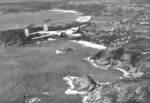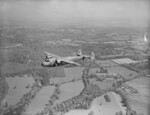DH.95 Flamingo
| Country | United Kingdom |
| Manufacturer | de Havilland Aircraft Company |
| Primary Role | Transport |
| Maiden Flight | 28 December 1938 |
Contributor: Alan Chanter
ww2dbaseBritish manufacturer de Havilland's first aircraft of all-metal stressed–skin construction, the DH.95 Flamingo was designed by R. E. Bishop as a medium-range transport to carry between 12 and 17 passengers in addition to its crew of three. The DH.95 featured hydraulically retractable landing gear and split trailing-edge flaps, and was powered by two 890-horsepower Bristol Pegasus XIIC radial engines. The prototype was first flown by de Havilland's chief test pilot, Geoffrey de Havilland Jr. at Hatfield on 28 December 1938 and during subsequent testing a centreline third fin was fitted temporarily to complement the original pair of endplate vertical tail surfaces. In May 1939 this aircraft was delivered to Guernsey & Jersey Airways Ltd. for route-proving trials, linking Heston and Southampton's Eastleigh Airport with the two main Channel Islands. However, the outbreak of World War II in 1939 precluded use of the type for scheduled services.
ww2dbaseMeanwhile the initial performance trials had attracted the attention of the British Air Ministry who having evaluated the prototype as a military transport in March 1939 ordered three Flamingo aircraft for the Royal Air Force. The two Flamingos ordered by the airline were diverted, along with the prototype, to No. 24 Squadron at RAF Hendon for use as VIP transports, and the third was delivered to the King's Flight at RAF Benson on 7 September 1940, for possible emergency evacuation of the Royal Family. This aircraft was subsequently transferred to No. 24 (VIP) squadron in February 1941. The squadron also acquired the airframe that the manufacturer had used for development with the Bristol Pegasus XVI supercharged radial engine. This engine was subsequently fitted to all later production Flamingo aircraft, including one, the 11th aircraft, which was impressed by the Admiralty in 1940 for use by the Royal Navy's No. 782 Squadron at RNAS Donibristle in Scotland, United Kingdom where it served the Orkneys and Shetlands and Northern Ireland. It was joined in 1945 by an ex-RAF Flamingo and was the only aircraft to return to civil use after World War II, seeing limited service, in its original civilian markings, with British Air Transport Ltd. at Redhill Aerodrome in Nutfield, Surrey, England, United Kingdom, until it was scrapped in 1954.
ww2dbaseSeven other Flamingo aircraft were flown by BAOC (created on 1 April 1940 by the amalgamation of Imperial Airways and British Airways) and based at Cairo, Egypt for Middle East routes, including services to Asmara, Aden, Addis Ababa, Adana, Jeddah and Lydda. Of these aircraft, two were lost in 1943 in separate crashes at Asmara, one crashed at Adana in 1942 and the other four were brought back to the UK, being scrapped at Redhill in 1950.
ww2dbaseFlamingo production ultimately totalled 16 aircraft, including the prototype, of which twelve were completed to civilian (impressed into wartime service) and three as military standard machines.
ww2dbaseAnother de Havilland project was the Hertfordshire which was to have been a fully militarised version of the Flamingo, to meet Air Ministry specification 19/39, for the carriage of up to 22 troops; only the prototype was completed and tested at Boscombe Down, becoming one of the aircraft sent to No. 24 Squadron, and the contract for forty was subsequently cancelled. The only visible difference in the Hertfordshire was the substitution of portholes for windows. The sole Hertfordshire crashed on 23 October 1940 killing five crew and six passengers, including Air Vice-Marshal Charles Blount, the commanding officer of No. 22 Group travelling from RAF Hendon to Belfast, Northern Ireland, United Kingdom, apparently due to jamming of the elevator.
ww2dbaseSources:
David Mondey: British Aircraft of World War II (Chancellor Press, 1994)
World Aircraft Information Files, File 892/16 (Aerospace Publishing Periodical)
Chaz Bowter: Royal Air Force Handbook 1939-1945 (Ian Allan Ltd., 1984)
Brenda Ralph Lewis: BOAC AT WAR (War Monthly, August 1981)
Last Major Revision: Aug 2023
DH.95 Flamingo Timeline
| 28 Dec 1938 | The DH.95 Flamingo transport aircraft took its maiden flight. |
| 23 Oct 1940 | The only example of the Hertfordshire aircraft crashed near RAF Hendon in London, England, United Kingdom, killing all 11 aboard, including Air Vice-Marshal Charles Blount. |
SPECIFICATIONS
DH.95
| Machinery | Two Bristol Pegasus XVI 9cyl, single-row, air-cooled radial piston engines rated at 930hp each |
| Armament | None; 12-17 passenger capacity |
| Crew | 3 |
| Span | 21.34 m |
| Length | 15.72 m |
| Height | 4.65 m |
| Wing Area | 60.48 m² |
| Weight, Empty | 5,137 kg |
| Weight, Loaded | 8,165 kg |
| Speed, Maximum | 391 km/h |
| Speed, Cruising | 328 km/h |
| Rate of Climb | 7.50 m/s |
| Service Ceiling | 6,370 m |
| Range, Normal | 2,165 km |
Photographs
 |  |  |  |
Please consider supporting us on Patreon. Even $1 per month will go a long way! Thank you. Please help us spread the word: Stay updated with WW2DB: |
- » US Government Plans to Purge WW2 Information (17 Mar 2025)
- » WW2DB's 20th Anniversary (29 Dec 2024)
- » Wreck of USS Edsall Found (14 Nov 2024)
- » See all news
- » 1,166 biographies
- » 337 events
- » 44,601 timeline entries
- » 1,243 ships
- » 350 aircraft models
- » 207 vehicle models
- » 376 weapon models
- » 123 historical documents
- » 261 facilities
- » 470 book reviews
- » 28,551 photos
- » 375 maps
Joachim von Ribbentrop, German Foreign Minister, Aug 1939
Please consider supporting us on Patreon. Even $1 a month will go a long way. Thank you!
Or, please support us by purchasing some WW2DB merchandise at TeeSpring, Thank you!